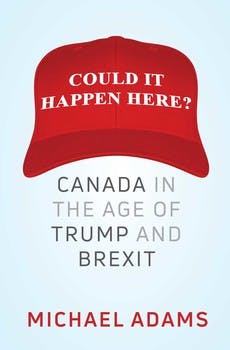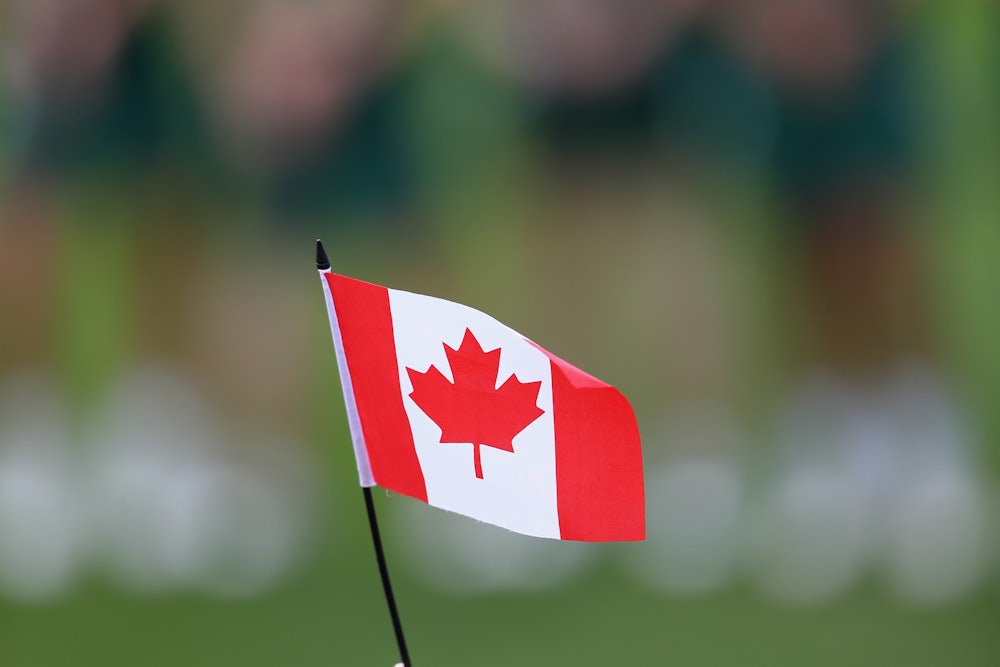Canadians have a complex relationship with the United States. On the one hand, Canadians share the world’s longest undefended border with the U.S., voraciously consume their pop culture, and speak with (almost) the same accent. But in spite of living right on top of the most powerful economic, military, and cultural force in the world, Americans and Canadians are growing further apart, not closer. How has a country of 35 million resisted being culturally, economically, and politically subsumed by a nation with 10 times the population and infinitely greater cultural output? And what happens when that powerful neighbor elects a leader who disregards the norms and values of the liberal world order?
That’s what Michael Adams seeks to answer in his new book, Could It Happen Here: Canada in the Age of Trump and Brexit. Adams has been monitoring Canadian political, economic, and social attitudes since the 1990s, back when NAFTA was newly in force and Canadians feared that their country would become indistinguishable from its southern neighbor. At the time, it seemed inevitable. In 2002, a poll of Canadians found that 58 percent of respondents said that they were becoming more like Americans. But when Adams asked the same question in the spring of 2017, only 27 percent of Canadians felt that way.

Much of what he sees taking place between Canada and the U.S. occurs in the context of history: Where Americans are now, Canadians have been before. Canada has already experienced a decade of media bashing, reactionary policy, attacks on science, and self-serving obfuscation by government officials. Because prior to the handsome, selfie-taking Justin Trudeau, Canadians had the Conservative Party and the aggressive Prime Minister Stephen Harper running the country from 2006 to 2015.
Elected by a mix of centrist voters upset with Liberal Party scandals and disenchanted, conservative-leaning suburbanites, Harper was a radical change for Canadians, and as his tenure dragged on, they didn’t like what they saw. What had once been a comparatively staid parliamentary process became an ideological battlefield driven by cultural resentments. In justifying new tough-on-crime legislation, justice minister Rob Nicholson said the government’s policies were instead going to be decided not by the best available data, but by “common sense,” and a rejection of the “educated urban elites who had the ear of government for decades.” One can almost hear the muffled screams from behind the mask of politeness that Canadians always wear.
This anti-elite, anti-information statement set the tone. The conservatives went on to eliminate the long-form census, a data collection tool that was essential to administering Canada’s historically large and interventionist government. The head of Statistics Canada, the government agency that oversees the census, resigned in protest. The census was the bedrock of evidence-based decision making in the country, helping inform policies like where to set electoral boundaries, devote healthcare funding, and countless other areas of governance. Later, the conservatives pulled out of the Kyoto Protocol. The idea was to force the Canadian government to rapidly shrink.
Much like the Trump administration, the Harper government erred toward ideologically-driven unilateralism. The era of conservative rule was meant to make Canada more American: more nationalistic in its tone, more austere in its social programs, and more conservative in its economic policy. But the public didn’t fall for the conservatives’ anti-elitist sentiment: The more experts decried Harper’s policies, the more unpopular those policies became. As Adams notes, in Canada, “public opinion in recent decades seems to have steadily followed elite consensus.” Climate change and environmental activism became more prominent in Canada the more the Harper government opposed it.
Adams’ strength is in his ability to masterfully explain the intricacies of the American political psyche, and deftly contrast them with Canadians’ own tendencies. Americans are “more inclined to be religious, risk-taking, aspirational, and money-focused.” Canadians, on the other hand, went in the opposite direction, being “more secular, risk averse, and self-effacing.” In politics, 58 percent of Canadians said they liked elected officials who made compromises, as opposed to just 40 percent of Americans. Adams makes a convincing case that these differences in attitudes are real, and that they lead to very different political realities.
Part of this difference is that Canadians trust government institutions in ways that Americans do not. For example, a recent statement by Donald Trump that he may not renew temporary protection status permits for some immigrants has sent a wave of predominantly Haitian refugees over the Canadian border into Quebec and Manitoba. While there has been grumbling over this influx—and some of it has been racist—most Canadians continue to believe that the government has handled immigration in a responsible way. The country continues to welcome over 300,000 immigrants a year, around 1 percent of its population, and none of the major political parties advocate for a cut in admissions. This kind of openness cannot happen in a country where the people do not trust state institutions to protect their best interests.
Canadian governments have generally behaved in the same way when it comes to refugee crises, irrespective of the party in power. In the late 1970s, it was Joe Clark’s Progressive Conservative government that admit 60,000 refugees from Southeast Asia, the so-called Boat People, to Canada. In 2015, when the Harper government tried to avoid admitting any Syrian refugees, the public backlash was substantial and many Canadians began to doubt the moral integrity of the conservatives’ position. Adams writes that, “Clark, and others from his 1979 cabinet, reminded Canadians of our previous generosity to the South-east Asians.”
It’s not that Canada is a postracial paradise with no history of racist oppression. Today, conditions in many indigenous communities have been described as “third-world.” Drinking water advisories have been issued in most communities in the past decade and now many grapple with a youth suicide crisis. Black Canadians suffer too, being barred from movie theaters in the early twentieth century and enduring the demolition of black communities like Africville, Nova Scotia. But unlike the U.S., the government has acknowledged and apologized for these and other injustices of the past; recent evidence shows that at least in terms of Canadian electoral politics, it does not pay to espouse racism publicly.
In fact, the Canadian right sees immigration as an electoral advantage. Many Canadian immigrants, particularly from China and South Asia, lean socially conservative, and make for natural Tory voters. The Conservative Party’s plans to win office in 2006 “ran directly through the heart of those urban and suburban neighborhoods that exemplify the new Canada, a country more positively invested in immigration than almost any other developed economy in the world,” Adams says. But by 2015, the party took an anti-immigrant tone. Sensing they had little to show for their decade in power, the conservatives decided upon fearmongering and anti-Muslim wedge politics. It didn’t work; in fact, Adams argues, this choice was what sealed its fate. They lost a staggering 60 seats in the 2015 election, dropping from 159 MPs to 99 MPs. In Canada, race resentment just doesn’t sell the way it does in the U.S.
After the Liberal victory in 2015, the conservatives found themselves at a crossroads. Sensing they want too far right, most politicians avoided sounding like Harper on social issues. The exception was Kellie Leitch, a candidate for Conservative Party chair who saw a path to victory through invoking an anti-elitist message and calling for the creation of a “Canadian values” test for new citizens. That didn’t work, either. Even among the conservatives, at least for the time being, race-baiting is no longer popular. Just 8 percent of eligible party voters supported her.
Could a Trump-style figure arise in Canada? The recent trends suggest no. But that doesn’t mean that Canada couldn’t field a politician that uses the same divisive, bombastic language to mobilize disgruntled voters. Some would say that with Harper, Canada has already proved its ability to be seduced by the right. And like the U.S., Canada faces deindustrialization, increasing inequality, and a growing presence of far right groups. All the ingredients are there.
But it’s unlikely that Canadian voters would be duped by a charismatic leader the way that Trump supporters have been. That’s because in Canada, no one who pays attention to politics can believe that if they simply elect the right person, all the changes that need to happen can be made. In Canada, a slow-by-design federal government means that all policy changes must be negotiated between the provinces and even among the cities. The process creates a lot of bureaucratic red tape, and it means that even desperately needed policy changes can happen at a glacial pace. But it also immunizes Canadians from thinking that any leader, alone, can fix their problems.
